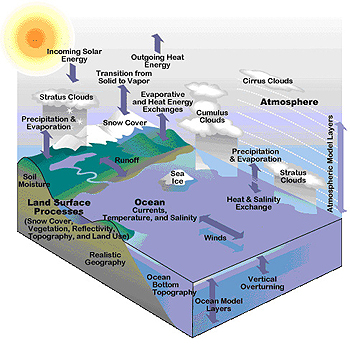Click on image for full size
UCAR
How Climate Models Work
A global climate model (GCM) uses hundreds of mathematical equations to describe processes that happen on our planet, processes like wind, ocean currents, and plant growth. Math is also used to describe how Earth processes are related to each other. For instance, how wind patterns affect the transport of storms from one area to another, how ocean currents affect the amount of heat in the atmosphere, and how plant growth affects the amount of carbon dioxide in the atmosphere. All these things, described with all this math, help scientists understand how Earth's climate works and how climate is changing.
Large climate models contain so many equations and are so complex that they need to be run on supercomputers. Using a supercomputer to keep up with the calculations, a model runs through simulated days, weeks, months, and years. Usually this is done to make climate predictions for one or more centuries into the future; sometimes models are run backwards to find out how climate may have changed in the past.
Global climate models represent how natural processes of our planet work using an imaginary three-dimensional grid. The grid isn’t really there. It is part of the model. It covers the surface of the modeled Earth and extends upward in layers through the modeled atmosphere. At every intersection in the model’s grid the model makes its calculations. Small processes that happen between a model’s grid points cannot be “seen” in the model results, but they can be described in other ways. Some models have wide spacing in the grid. This means that there are fewer points where the model calculates. These models run faster and are useful when less detail is needed. Some models have very closely spaced grid points. These are much more detailed models and it can take a long time for the supercomputer, even a fast one, to run the model.















